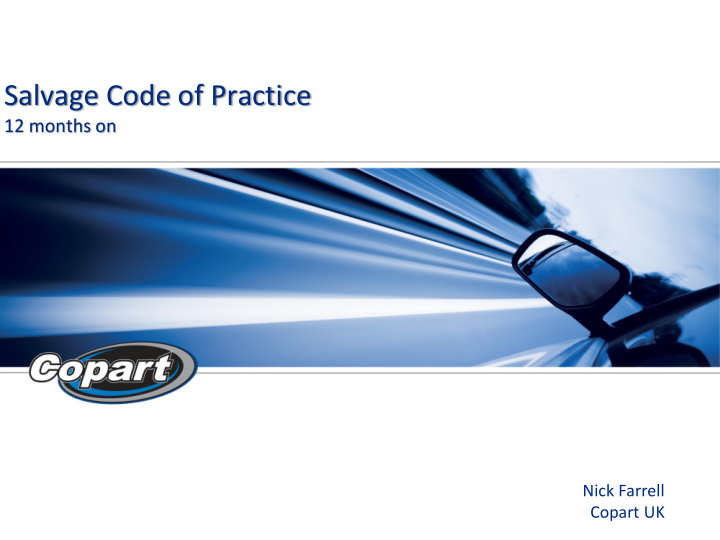



Salvage Code of Practice 12 months on Nick Farrell Copart UK
What we thought we would see No change to straight to Salvage model • An obvious total loss has remained as such Some Salvage Buyer uncertainty • Extensive marketing campaign to our Buyers helped mitigate this, but we still fielded lots of enquiries after go live We would begin to understand the shift in categories and values towards the end of January 2018 • Wasn’t fully implemented by all credit hire companies due to….. Cat C and D vehicles would be more attractive to Buyers as the new COP got near and after go live • This proved to be the case and continues today. We expected to see first vehicle on the new categories to be sold in the first few weeks • A vehicle sold under the new categories during the first week of new COP implementation
What we thought we would see Category Mix There would be a shift in Structural vehicles being newer and of higher value than Non Structural Proportionately more Non Structural vehicles would emerge from existing Cat C and D categories • We found this to be the case Engineering 1 in 4 cases would require more information/a physical inspection Engineers would possibly err on the side of caution when categorising • 27.4 % benefit from an inspection, of those 16.5% changed from S to N
The shift from old to new COP Cars and LCVs Pre COP – CAT mix Post COP - CAT Mix 44.04% 32.38% 26.92% 25.57% 16.45% 14.34% 14.05% 13.36% 14.34% 14.05% 1.46% 1.13% 0.54% 0.78% CAT A CAT B CAT S CAT N CAT U CAT X 1.46% 0.54% Pre COP Post COP CAT A CAT B CAT C CAT D CAT U CAT X • Engineers err on the side of caution around category B vehicles • More equal distribution on N & S’s compared to C & D’s
The shift from old to new COP MotorBikes Pre COP - CAT Mix Post COP - CAT Mix 37.24% 36.73% 46.45% 21.54% 21.54% 20.15% 7.05% 6.66% 3.95% 3.32% 0.86% 0.88% 7.05% CAT A CAT B CAT N CAT U CAT X 3.95% 0.86% Pre COP Post COP CAT A CAT B CAT C CAT D CAT U CAT X • Significant increase in category B as no option for category S • Repairable propositions being moved to category B
A Shift in thinking? • Many of our customers have taken the opportunity to change their processes and factor in all the effects of a total loss journey • We are seeing vehicle returns at auction featuring more in the repair or TL process • Complexity of repair • Parts availability • Vehicle mobility costs • Policy Holder experience • Our customers don’t just see it as salvage, they see and understand the overall value that can be delivered
Examples of a different approach Average PAV & Age - Structural 9 7,000 8.8 6,000 8.6 5,000 8.4 4,000 8.2 3,000 8 2,000 7.8 1,000 7.6 7.4 0 Nov-17 Dec-17 Jan-18 Feb-18 Mar-18 Apr-18 May-18 Jun-18 Jul-18 Aug-18 Average Age at Sale Average PAV
Summary • There still remains confusion and inconsistencies • Cold repair to Structurally damaged vehicles • ELV’s • Classic cars/cars of special interest • Physical Inspections are required for accurate Categorisation and to avoid loss of value • Motorbikes, bikes with similar damage to some Cat B’s are being repaired through Networks • Copart Buyers have adapted well, do Consumers understand? • When is the review happening, what influence will the Industry have?
Recommend
More recommend